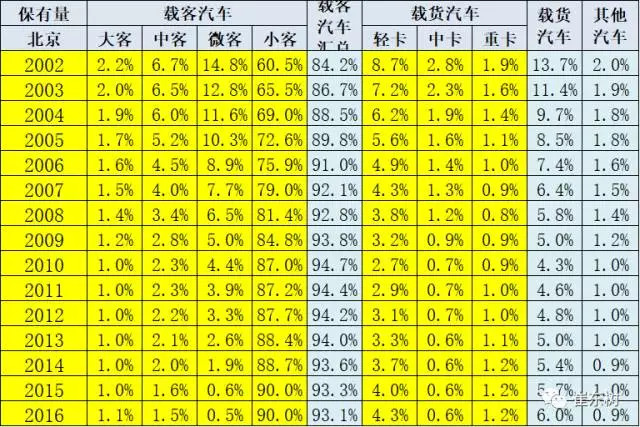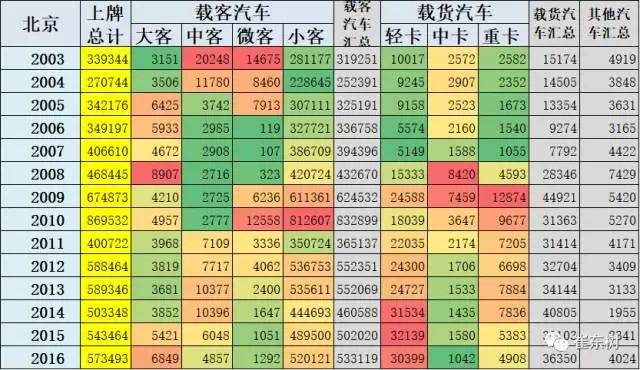On December 15, the Beijing Municipal Transportation Commission issued the total amount and allocation ratio of Beijing minibus indicators in 2018, and announced the 2017 edition of the “Interim Provisions on the Control of the Number of Passenger Cars in Beijingâ€. In 2018, the total number of minibus indicators fell from 150,000 to 100,000, of which new energy indicators remained unchanged at 60,000, and ordinary indicators decreased from 90,000 to 40,000. The index is tilted toward individuals, and the number of individual ordinary vehicles has changed to 38,000. The number of new energy indicators will exceed that of ordinary vehicles for the first time.

Beijing Automotive Market Overview
1. Overview of Beijing's ownership, licensing, and withdrawals

According to the China Statistical Yearbook data, Beijing maintained 5.47 million units as of the end of 2016, an increase of 136,300 over 15 years. In 2006, it had 570,000 units on the market, an increase of 30,000 units over 16 years. Due to the increase in Beijing's scrapping and transfer efforts in recent years, the renewal of old vehicles has greatly promoted the Beijing market. In the 12-15 years, 350,000 units were scrapped every year. On the basis of that, there were about 510,000 units scrapped and scrapped in 15 years and 430,000 units in 16 years. It can be seen that the Beijing market has a high status of ownership in the national market, and the outflow of used cars is large. New car sales are also very strong.
2. Analysis of changes in the stock of Beijing market

The main growth of Beijing's market share is the continuous growth of trucks, which reached a high of 6% in 16 years and higher than all years after 2008, reflecting the strong demand for trucks in big cities.
Beijing's demand for heavy trucks is strong. After 02 years, the number of people on the road has continued to fall. By 2007, it will have reached the bottom of 23,000 units. However, it began to pick up in 2007 and it has now reached 60,000 units.
The proportion of passenger cars in Beijing has continuously declined from 94.7% in 10 years to 93.1% in 16 years. The market in Beijing is dominated by small passenger cars, which account for 90% of the total, and is a feature of gradual growth. The growth of minibuses is mainly eroding the micro-customer market.
3. The number of cards in Beijing adjusted with the policy

The size of the cards on the market in Beijing is extremely large, reaching 869,500 units in 2010, and is also fluctuating when the limit-limit policy changes.
There were only 400,000 Beijing cards in 2011. On December 27th, 2011, the implementation details were revised for the first time. The revised contents mainly included the following: Firstly, the indicator of unused individual passenger cars was re-instated into the configuration of the Yaobao pool; second, the application period of personal allocation indicators was stipulated, and the number of codes in the Yaohao pool was reduced; The newly registered companies are allowed to participate in the Yaohao to facilitate the development of the enterprise. Fourth, the time limit for the application of indicators is updated and the management of indicators is strengthened. On this basis, Beijing has 588,000 cards in 2012.
In 2013, both Beijing's licensing and 2012 were 589,000 units. On November 27, 2013, the Regulations were revised again. The revised contents mainly included: setting the individual's Yaohao ladder's success rate in order to ease the pressure of “shaking it for a long timeâ€; increasing the allocation of new energy minibus indicators; and solving the problem of stolen passenger cars. After applying for indicators; cooperate with the court in this Municipality to implement judicial auctions. As a result, the total number of licenses in 2014 decreased by 90,000, and the utilization rate of 20,000 new energy sources was not high. As a result, Beijing’s licensing in 2014 was reduced to 500,000 units, a decrease of 85,000 units in 13 years. In 2015, the recognition of new energy vehicles increased, and the number of purchasers increased significantly, pushing the brand up to 540,000 in 15 years.
In 2016, Beijing had 573,000 units on the market, an increase of 40,000 units compared to 2015. On January 22, 2016, further adjustments were made to the advanced step-by-step rule for the average number of passengers on the Yaozhan ladder and increase the degree of care for applicants who had “shaken for a long timeâ€. The "Notice on the Application of the Regulations on the Application of New Energy Passenger Cars Configuration Indicators" has been issued, and the new energy minivan index has been abolished. The policy effect is also a good promotion for Beijing's 2017 new energy vehicle sales.
The impact of the latest limit policy in Beijing
1. Limiting license policy will not spread
Because the number of traditional car Yaos in Beijing dropped from 240,000 in 11 years to 130,000 in 14 years, 15 years to 120,000, 16 years to 90,000, and 18 years to 40,000. It is difficult for consumers who currently buy private cars to purchase cars through the Yaohao.
Restrictions on other cities are currently impossible to implement. Because there is currently no effective mitigation measures for the restriction of purchase policies, the group of shakers who limit purchases still cannot alleviate. Moreover, the management of road rights in motor vehicles cannot strictly control vehicles in the field. Therefore, more cities will not pass the purchase restriction method, but will need greater wisdom to solve the congestion problem.
2. Congestion should be restricted - not limited
The congestion in Beijing and other cities is mainly due to the high frequency of car use and the difficulty of urban traffic management. At present, the use of economic measures to curb the effect of travel by car owners is poor. It can only be resolved through purchase restrictions.
3. The timetable for Beijing to stop selling traditional fuel vehicles has accelerated
In 2018, the number of newly purchased fuel vehicles in Beijing is lower than that of electric vehicles. In the future, there seems to be a tendency for newly purchased vehicles to stop buying traditional fuel vehicles. This is also a timetable for stopping the sale of traditional fuel vehicles, which we said has rapidly advanced in Beijing.
4, Beijing's electric car is also difficult to find a car
At present, there are approximately 120,000 new energy vehicles queued in Beijing, which is far more than the supply of new energy vehicles in the next two years. Therefore, many of the traditional car groups queuing at the beginning of 2018 will also buy new energy vehicles and increase the queuing pressure of new energy vehicles, which will inevitably lead to a substantial increase in the number of queues for new energy vehicle purchases in Beijing.
5. Local subsidies for new energy vehicles in Beijing may decrease
There are rumors that the cancellation of local subsidies, which is also the impact of Beijing's unique demand. Although there is no subsidy that will allow Beijing people to buy new energy vehicles, subsidy to car companies is ultimately a good thing.
In short, the reduction in the number of traditional cars in Beijing is a greater pressure on the auto market, and it is not a big boost to new energy sources, but it has a significant impact on Beijing consumers.
Corn Thresher,Corn Sheller,Hand Corn Sheller,Corn Sheller Machine
Hunan Xinta Machinery Manufacturing Co., Ltd. , https://www.china-agricultural-product.com